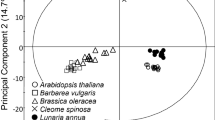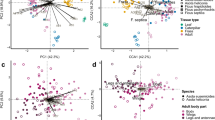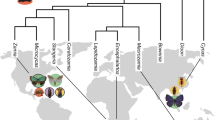Abstract
Evolution has shown the co-dependency between host plants and predators (insects), especially inevitable dependency of predators on plant biomass for securing their energy sources. It was postulated that NAD+ source used for major energy producing pathway is the glycerol-3-phosphate shuttle in insects. Using high throughput metabolomics approach, we found that larva of leaf beetle (Gastrophysa atrocyanea), which feed oxalate-rich plants (Rumex obtusifolius), possessed a unique mechanism for accumulating unusually high amounts of lactate. Similarly, larva of butterfly (Papilio machaon) fed with fennel (Foeniculum vulgare) accumulated lactate. Same butterfly also showed the elevated level of glycerol-3-phosphate equivalent to lactate. These evidences provide new insights into the mechanism underlying metabolite alteration between host plants and insect herbivores.





Similar content being viewed by others
References
Candy, D. J., & Kilby, B. A. (1975). Insect biochemistry and function. London/New York: Chapman and hall/Wiley.
Dickie, C. W., Hamann, M. H., Carroll, W. D., & Chow, F. (1978). Oxalate (Rumex venosus) poisoning in cattle. Journal of the American Veterinary Medical Association, 173, 73–74.
Kaddurah-Daouk, R., Kristal, B. S., & Weinshilboum, R. M. (2008). Metabolomics: A global biochemical approach to drug response and disease. Annual Reviews of Pharmacology and Toxicology, 48, 653–683.
Miyagi, A., Takahara, K., Kasajima, I., Takahashi, H., Kawai-Yamada, M., & Uchimiya, H. (2011). Fate of 13C in metabolic pathways and effects of high CO2 on the alteration of metabolites in Rumex obtusifolius L. Metabolomics, 7, 524–535.
Miyagi, A., Takahashi, H., Takahara, K., Hirabayashi, T., Nishimura, Y., Tezuka, T., et al. (2010a). Principal component and hierarchical clustering analysis of metabolites in destructive weeds; polygonaceous plants. Metabolomics, 6, 146–155.
Miyagi, A., Takahara, K., Takahashi, H., Kawai-Yamada, M., & Uchimiya, H. (2010b). Targeted metabolomics in an intrusive weed, Rumex obtusifolius L., grown under different environmental conditions reveals alterations of organ related metabolite pathway. Metabolomics, 6, 497–510.
Miyagi, A., Uchimiya, M., Kawai-Yamada, M., & Uchimiya, H. (2013a). Impact of aluminium stress in oxalate and other metabolites in Rumex obtusifolius. Weed Research, 53, 30–41.
Miyagi, A., Uchimiya, M., Kawai-Yamada, M. & Uchimiya, H. (2013b). An antagonist treatment in combination with tracer experiments revealed isocitrate pathway dominant to oxalate biosynthesis in Rumex obtusifolius L. Metabolomics, 9, 590–598.
Neermann, I., & Wagner, R. (1996). Comparative analysis of glucose and glutamine metabolism in transformed mammalian cell lines, insect and primary liver cells. Journal of Cellular Physiology, 166, 152–169.
Nicholson, J. K., Wilson, I. D., & Lindon, J. C. (2011). Pharmacometabonomics as an effector for personalized medicine. Pharmacogenomics, 12, 103–111.
Ojima, N., Ikeda, S., Koike, O., Fujita, K., & Suzuki, K. (2005). Continuous rearing of an entomoresource, the leaf beetle, Gastrophysa atrocyanea Motschulsky (Coleoptera: Chrysomelidae) on artificial diets. Applied Entomology and Zoology, 40, 119–124.
Panciera, R. J., Martin, T., Burrows, G. E., Taylor, D. S., & Rice, L. E. (1990). Acute oxalate poisoning attributable to ingestion of curly dock (Rumex crispus) in sheep. Journal of the American Veterinary Medical Association, 196, 1981–1984.
Pauw, A., Stofberg, J., & Waterman, R. J. (2009). Flies and flowers in Darwin’s race. Evolution, 63, 268–279.
Pedersen, T. H., Nielsen, O. B., Lamb, G. D., & Stephenson, D. G. (2004). Intracellular acidosis enhances the excitability of working muscle. Science, 305, 1144–1147.
Reig, R., Sanz, P., Blanche, C., Fontarnau, R., Dominguez, A., & Corbella, J. (1990). Fatal poisoning by Rumex crispus (curled dock): Pathological findings and application of scanning electron microscopy. Veterinary and Human Toxicology, 32, 468–470.
Schauer, N., & Fernie, A. R. (2006). Plant metabolomics: Towards biological function and mechanism. Trends in Plant Sciences, 11, 508–516.
Shulaev, V., Cortes, D., Miller, G., & Mittler, R. (2008). Metabolomics for plant stress response. Physiologia Plantarum, 132, 199–208.
Suzuki, K., Hosaka, M., & Miya, K. (1984). The amino acid pool of Bombyx mori eggs during diapause. Insect Biochemistry, 14, 557–561.
Tanaka, K., Uda, Y., Ono, Y., Nakagawa, T., Suwa, M., Yamaoka, R., et al. (2009). Highly selective tuning of a silkworm olfactory receptor to a key mulberry leaf volatile. Current Biology, 19, 881–890.
Toju, H. (2011). Weevils and camellias in a Darwin’s race: Model system for the study of eco-evolutionary interactions between species. Ecological Research, 26, 239–251.
Xiao, Y., Wang, Q., Erb, M., Turlings, T. C. J., Ge, L., Hu, L., et al. (2012). Specific herbivore-induced volatiles defend plants and determine insect community composition in the field. Ecological Letters, 15, 1130–1139.
Xu, W. H., Lu, Y. X., & Denlinger, D. L. (2012). Cross-talk between the fat body and brain regulates insect developmental arrest. Proceedings of the National Academy of Sciences of the United Sates of America, 109, 14687–14692.
Zaller, J. G. (2004). Ecology and non-chemical control of Rumex crispus and R. obtusifolius (Polygonaceae): A review. Weed Research, 44, 414–432.
Zebe, E. C., & McShan, W. H. (1957). Lactic and alpha-glycerophosphate dehydrogenases in insects. The Journal of General Physiology, 40, 779–790.
Acknowledgments
This research was supported by a Grant from the Program for Promotion of Basic and Applied Researches for Innovations in Bio-oriented Industry (BRAIN), and Grants from MEXT, Japan.
Author information
Authors and Affiliations
Corresponding author
Electronic supplementary material
Below is the link to the electronic supplementary material.
Rights and permissions
About this article
Cite this article
Miyagi, A., Kawai-Yamada, M., Uchimiya, M. et al. Metabolome analysis of food-chain between plants and insects. Metabolomics 9, 1254–1261 (2013). https://doi.org/10.1007/s11306-013-0542-9
Received:
Accepted:
Published:
Issue Date:
DOI: https://doi.org/10.1007/s11306-013-0542-9




